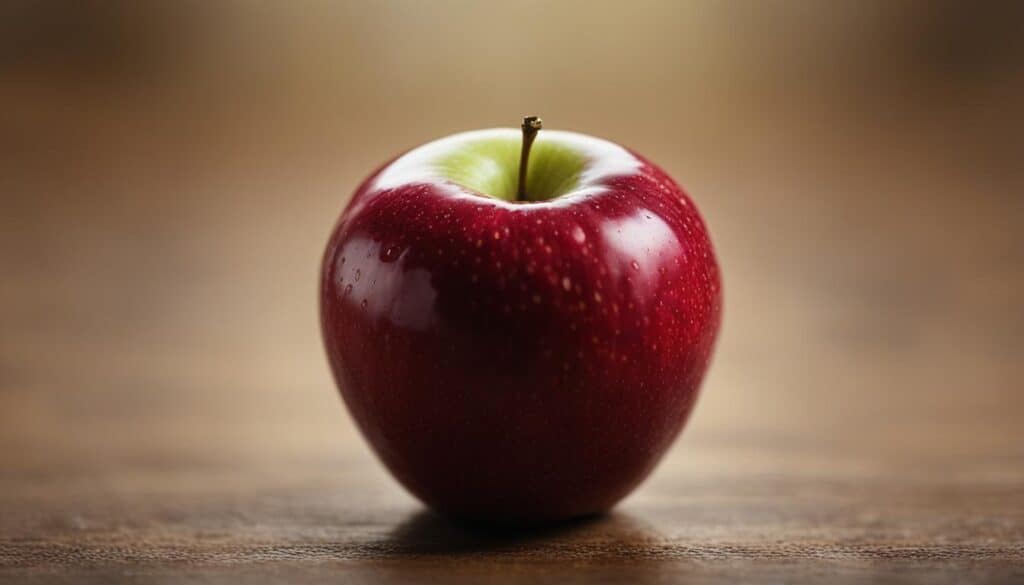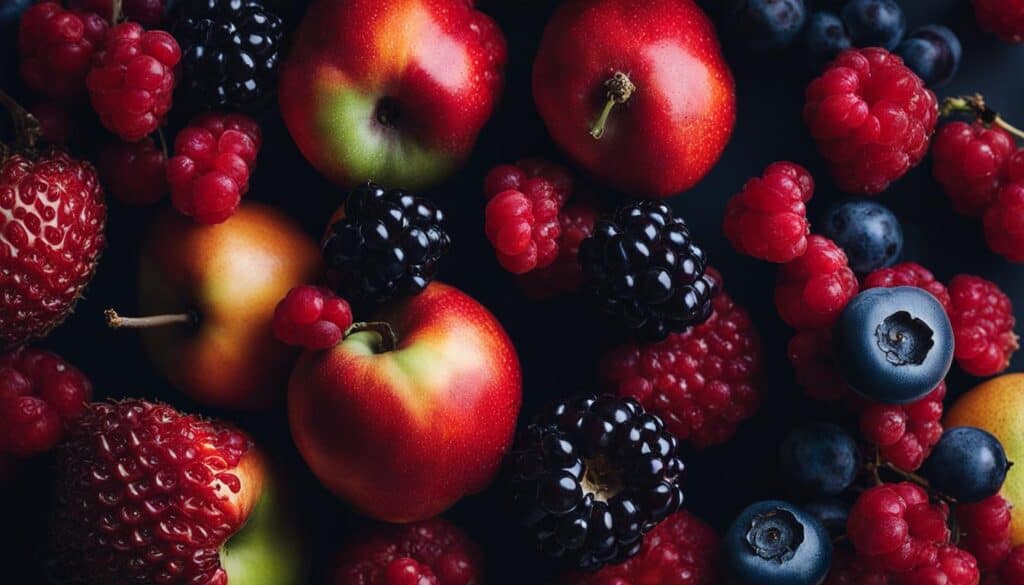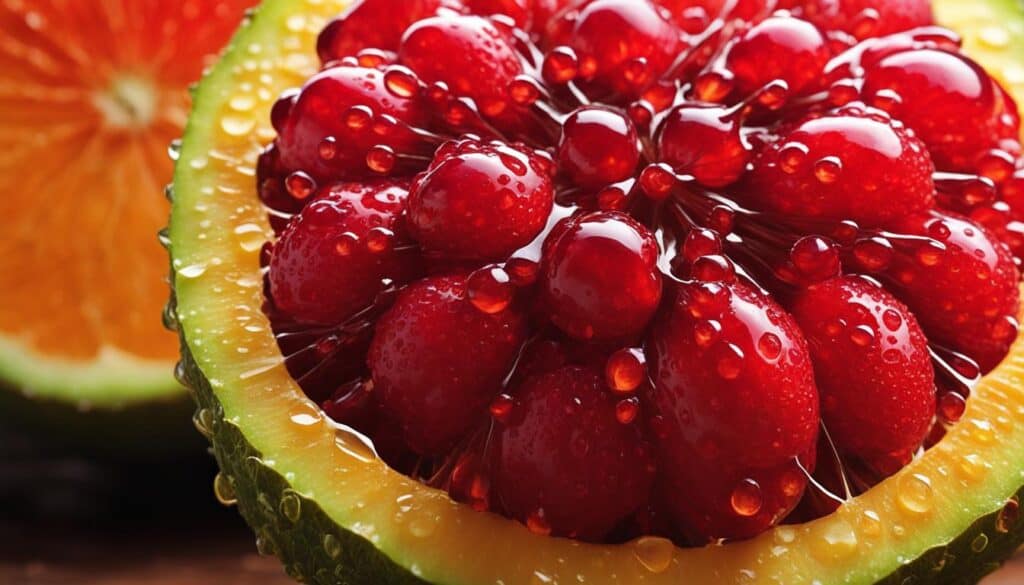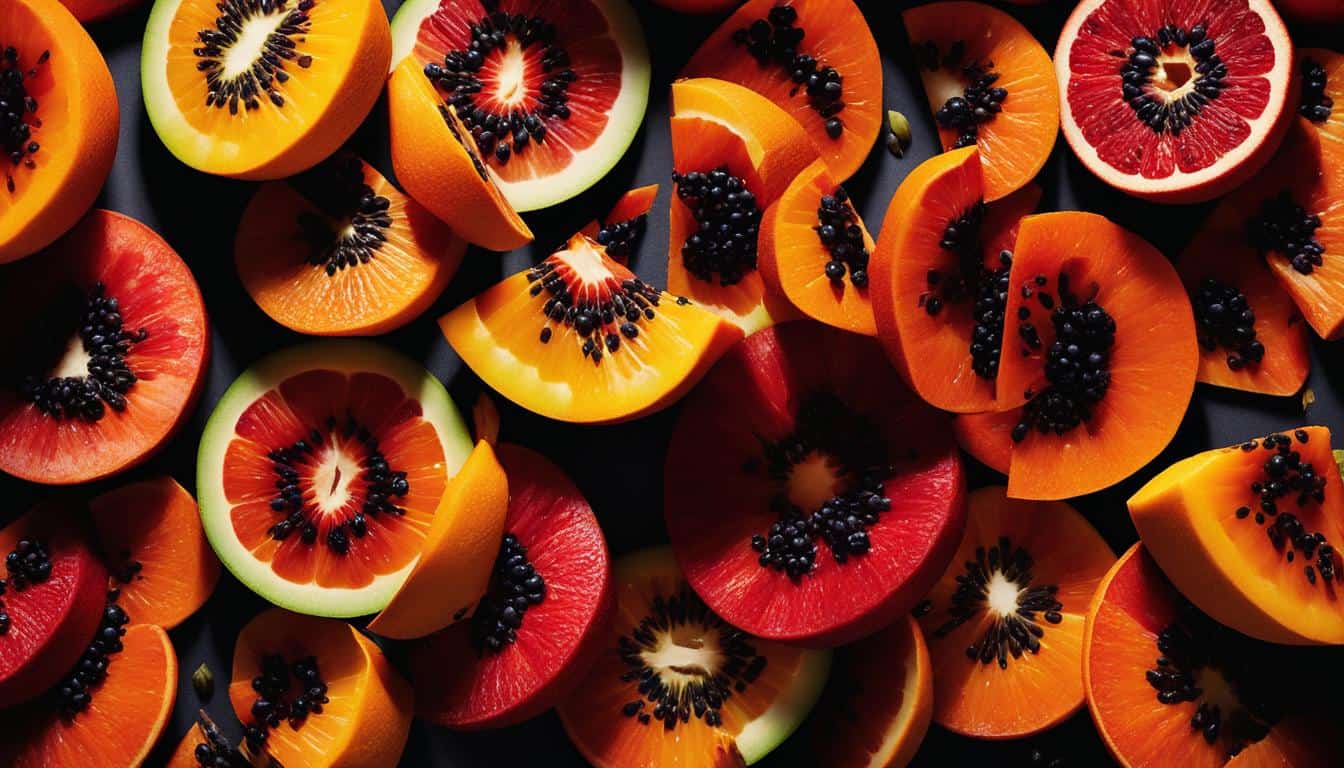Welcome to my blog post about fruit close-up photography! In this article, I will share some valuable tips to help you capture stunning images that showcase the intricate details and vibrant colors of your favorite fruits. Whether you’re a beginner or an experienced photographer, these tips will enhance your skills and inspire you to create beautiful visuals that celebrate the beauty of nature’s bounty.
Close-up photography allows us to explore the mesmerizing world of fruits up close. By magnifying the details, we can reveal the hidden beauty that often goes unnoticed. From the minute textures of a strawberry to the radiant hues of a ripe citrus fruit, capturing these elements can create breathtaking images that engage the viewer.
Are you ready to take your fruit photography to the next level? Let’s dive into some essential tips and techniques that will elevate your fruit close-up photography!
Key Takeaways:
- Explore stunning macro fruit photography ideas to capture the intricate details and vibrant colors of your favorite fruits.
- Find inspiration from photographers on platforms like Pinterest and Instagram who share their mesmerizing macro fruit photography.
- Choose fruits with interesting textures, vibrant colors, and unique shapes to create visually appealing close-up images.
- Experiment with different lighting techniques to enhance the details and textures of the fruit.
- Apply composition principles like the rule of thirds, leading lines, and symmetry to create visually pleasing images.
Finding Inspiration for Fruit Close Up Photography
When it comes to macro fruit photography, finding inspiration is key to creating stunning and unique images. Scrolling through platforms like Pinterest and Instagram can offer a world of ideas and techniques that will ignite your creativity and take your fruit photography to the next level.
Explore stunning macro fruit photography ideas shared by talented photographers who have an eye for capturing the intricate details and vibrant colors of fruits. Observe their compositions, lighting techniques, and color palettes that make their fruit photography truly stand out.
On Pinterest, you can find curated collections of fruit close up photography that serve as a wealth of inspiration. Browse through boards dedicated to macro fruit photography, where photographers share their best shots along with tips and tricks.
“Photography is the art of frozen time… the ability to store emotion and feelings within a frame.” – Meshack Otieno
Instagram is another platform where photographers display their talent and inspire others. Search for hashtags related to fruit photography, such as #macrofruitphotography or #fruitphotography, to discover a diverse range of styles and approaches.
Take note of the composition techniques used by photographers, like the rule of thirds or leading lines, to create visually pleasing and balanced images. Experiment with different lighting setups, such as natural light or artificial light, to add depth and drama to your photos.
Let the vibrant and diverse world of macro fruit photography on social media ignite your imagination and provide you with endless fruit photography ideas and inspiration. Embrace your unique style and create captivating images that showcase the beauty of nature’s bounty.
| Inspiration Platforms | Description |
|---|---|
| A visual discovery platform where photographers share their best fruit close up photography shots. Browse through curated boards for inspiration and tips. | |
| A social media platform where photographers showcase their talent. Search for hashtags like #macrofruitphotography or #fruitphotography for a vibrant array of fruit photography styles. |
Choosing the Right Fruit for Close Up Photography
When it comes to fruit close up photography, selecting the right fruits can make all the difference. By choosing fruits with interesting textures, vibrant colors, and unique shapes, you can create visually appealing images that capture the essence of nature’s bounty. Here are a few fruits that are perfect for macro fruit photography:
1. Strawberries
Strawberries with their bright red color and tiny seeds can add a pop of vibrancy to your close up photographs. Experiment with different angles to capture their unique shape and texture.
2. Citrus Fruits
Citrus fruits like oranges and lemons offer a refreshing burst of color and intricate patterns on their peels. Get up close to capture the texture and detail of the citrus skin, adding a zesty element to your fruit photography.
3. Apples
Apples are not only delicious but also visually captivating. Their smooth skin and range of colors, from vibrant reds to mellow greens, make them an excellent subject for close up shots.
4. Pomegranates
Pomegranates with their jewel-like seeds and deep red hues can create stunning macro fruit photography. Try capturing the juicy texture and intricate patterns of the pomegranate to add a touch of elegance to your compositions.
Remember, these are just a few examples, and there are many more fruits to explore. Each fruit offers its own unique characteristics that can enhance your close up photography. Don’t be afraid to experiment and let your creativity shine!
| Fruit | Unique Characteristics |
|---|---|
| Strawberries | Bright red color, tiny seeds |
| Citrus Fruits | Refreshing colors, intricate peel patterns |
| Apples | Smooth skin, range of vibrant colors |
| Pomegranates | Jewel-like seeds, deep red hues |
Lighting Techniques for Fruit Close Up Photography
When it comes to fruit close up photography, lighting plays a crucial role in capturing the intricate details and textures of the fruit. By experimenting with different lighting techniques, you can create stunning images that truly showcase the beauty of nature’s bounty.
Natural Light: One of the most popular lighting options for fruit photography is natural light. This soft and diffused light can create a gentle glow around the fruit, highlighting its vibrant colors and delicate features. Consider shooting near a window or outdoors during the golden hours of sunrise or sunset for beautiful natural lighting.
Artificial Light: Artificial lighting can offer more control over the lighting conditions and allow you to create dramatic effects in your fruit photography. Experiment with different types of artificial lights, such as studio lights, continuous lighting, or even LED lights, to achieve the desired look. Using a combination of directional and diffused lighting can help create interesting shadows and highlights.
Reflectors and Diffusers: To further refine the lighting in your fruit close up photography, consider using reflectors and diffusers. Reflectors bounce light onto the fruit, filling in shadows and adding a touch of brightness to the composition. Diffusers, on the other hand, help soften and scatter the light, resulting in a more evenly lit subject. Play around with different sized reflectors and diffusers to achieve the right balance of light and shadow.
Remember, lighting is a powerful tool in photography, and understanding how to manipulate it will greatly impact the outcome of your fruit close up images. Take the time to experiment with both natural and artificial lighting techniques, and don’t be afraid to get creative with reflectors and diffusers to achieve the desired effect.
| Lighting Technique | Description |
|---|---|
| Natural Light | Soft and diffused light that creates a gentle glow around the fruit, highlighting its vibrant colors and delicate features. |
| Artificial Light | Offers more control over lighting conditions and allows for the creation of dramatic effects. |
| Reflectors | Bounce light onto the fruit, filling in shadows and adding brightness to the composition. |
| Diffusers | Soften and scatter light, resulting in a more evenly lit subject. |
Composition Tips for Fruit Close Up Photography
When it comes to capturing stunning fruit close up photography, composition plays a crucial role in creating visually pleasing and captivating images. By applying composition techniques such as the rule of thirds, leading lines, and symmetry, you can enhance the overall impact of your photographs.
The rule of thirds: This technique involves dividing your frame into a 3×3 grid using imaginary lines. Place your subject along these lines or at their intersection points to create a balanced and visually appealing composition. For fruit close up photography, consider positioning the focal point of the fruit, such as a strawberry or an orange slice, along one of these grid lines to draw the viewer’s eye.
Leading lines: Utilizing leading lines can guide the viewer’s gaze and add depth to your fruit close up photographs. Look for natural lines within the fruit, like the curves of a sliced kiwi or the veins of a strawberry, and use them to lead the viewer’s eye towards the main subject. Experiment with different angles and perspectives to incorporate these lines into your composition.
Symmetry: Symmetry can create a sense of balance and harmony in your fruit close up photography. Look for fruits that have symmetrical shapes, such as apples or pears, and experiment with positioning them centrally within the frame. By capturing the symmetrical details of the fruit, you can create visually striking and aesthetically pleasing compositions.
Additionally, don’t be afraid to explore different angles, perspectives, and depths of field to add visual interest to your fruit close up photography. Get up close and personal with your subject to capture the intricate details, or experiment with a shallow depth of field to create a dreamy and ethereal effect.

Engage your viewers with visually appealing and creative compositions in your fruit close up photography. The right composition techniques can elevate your photographs from ordinary to extraordinary, allowing the vibrant colors and textures of the fruit to shine through.
Editing and Post-Processing Fruit Close Up Photography
Once you have captured your stunning fruit close up photographs, it’s time to bring them to life through the power of editing and post-processing. With photo editing software like Adobe Lightroom or Photoshop, you can enhance the colors, contrast, and sharpness of your images to create captivating visuals that truly stand out.
Experimentation is key when it comes to editing your fruit close up photographs. Try out different filters and adjustments to achieve the desired look and feel. Here are some techniques and tips to consider:
- Adjust the exposure: Fine-tune the exposure settings to ensure the fruit is well-lit and the details are clearly visible. Be cautious not to overexpose or underexpose the image, as it can affect the overall outcome.
- Enhance the colors: Fruit photography is all about capturing vibrant and juicy colors. Utilize the color correction tools in your editing software to make the colors pop. You can also adjust the saturation and vibrance settings for a more intense look.
- Sharpen the details: To highlight the intricate textures of the fruit, use the sharpening tools to add clarity. Be careful not to over-sharpen, as it can create an unnatural appearance.
- Remove distractions: During the editing process, take a closer look at the image and remove any distracting elements or imperfections. Clone stamp or healing brush tools can help you eliminate unwanted spots or blemishes.
Remember, the goal of editing is to enhance the beauty and impact of your fruit close up photographs without losing their natural essence. Experiment with different editing techniques, but always strive for a result that looks true to life.
Let’s take a look at an example of the transformation editing can bring to a fruit close up photograph:

Equipment and Gear for Fruit Close Up Photography
When it comes to capturing the intricate details of fruit up close, having the right equipment and gear is essential. Here are some recommendations to enhance your macro fruit photography:
- Macro Lens: Invest in a high-quality macro lens to capture the finest details of the fruit. The macro lens allows you to get up close and personal, revealing the textures and patterns that are often unseen by the naked eye. It’s a must-have tool for achieving stunning macro fruit photography.
- Extension Tubes: If a macro lens is not within your budget, extension tubes can be a more affordable alternative. These tubes can be attached between your camera body and lens, allowing you to focus closer and magnify the subject.
- Tripod: Use a sturdy tripod to eliminate camera shake while shooting. This is especially important when capturing close up shots, as any slight movement can result in blurry images. A tripod provides stability and ensures sharpness in your photographs.
- Remote Shutter Release: To further minimize camera shake, use a remote shutter release or self-timer function. This allows you to trigger the shutter without physically touching the camera, resulting in sharper images.
- Props and Backgrounds: Experiment with different props and backgrounds to add visual interest to your fruit close up photographs. Consider using a marble slab, wooden cutting board, or colorful fabric as the backdrop to complement the fruit. Incorporating props such as vintage silverware or fresh herbs can also enhance the composition.
“Having the right equipment is important, but it’s your creativity and vision that truly bring your fruit close up photography to life.”
Remember, while having the right tools can make a difference, creativity and a keen eye for detail are equally important. Experiment with different setups and techniques to find your unique style in capturing the beauty of fruits up close.

Tips for Choosing the Perfect Macro Lens
When selecting a macro lens, consider factors such as the focal length and maximum aperture:
| Lens | Focal Length | Maximum Aperture |
|---|---|---|
| Nikon AF-S VR Micro-Nikkor 105mm f/2.8G IF-ED | 105mm | f/2.8 |
| Canon EF 100mm f/2.8L Macro IS USM | 100mm | f/2.8 |
| Sony FE 90mm f/2.8 Macro G OSS | 90mm | f/2.8 |
| Tamron SP AF 90mm f/2.8 Di Macro | 90mm | f/2.8 |
Styling and Props for Fruit Close Up Photography
When it comes to fruit close up photography, styling and props play a crucial role in creating visually appealing images that capture the viewer’s attention. By using cutting boards, plates, fabrics, and various elements, you can add interesting backgrounds and textures to enhance your fruit photography composition.
To create a captivating story with your images, consider incorporating additional elements such as flowers, herbs, or spices. These props not only provide visual interest but also add depth and character to your fruit close up photographs. Experiment with different combinations and arrangements to find the perfect composition that tells a unique story through your lens.
Remember, the purpose of styling and props is to complement the fruit and create a cohesive and visually pleasing composition. Be mindful of the colors, textures, and themes you choose, ensuring they align with the mood and message you want to convey in your photographs. Let your creativity flow and explore different possibilities to make your fruit photography truly one-of-a-kind.
Examples of Props for Fruit Close Up Photography
| Props | Usage |
|---|---|
| Cutting boards | Provides a rustic, organic feel |
| Plates | Adds elegance and sophistication |
| Fabrics | Brings texture and depth to the composition |
| Flowers | Introduces a touch of beauty and freshness |
| Herbs or spices | Enhances aroma and adds an element of flavor |
Example Image:

Tips for Capturing Vibrant Colors in Fruit Close Up Photography
When it comes to fruit close up photography, capturing vibrant colors is essential to create visually stunning images. The colors of the fruit can evoke emotions and enhance the overall aesthetics of the photograph. Here are some tips to help you bring out the vibrant colors in your fruit close up photographs:
Experiment with Different Fruits and Their Natural Colors
Each fruit has its own unique color palette. Experiment with a variety of fruits to discover the vibrant colors they offer. From the rich reds of strawberries to the bright yellows of lemons, there is a world of colors waiting to be explored. Capture the intricate patterns and shades of the fruits to add depth and visual interest to your photographs.
Play with Complementary or Contrasting Colors
Understanding color theory can greatly enhance your fruit close up photography. Experiment with using complementary or contrasting colors to make the fruit stand out. Complementary colors are opposite each other on the color wheel, such as blue and orange or red and green. When combined, they create a visually striking effect. Contrasting colors, on the other hand, are colors that are positioned far apart on the color wheel and create a bold visual impact when used together.
| Complementary Colors | Contrasting Colors |
|---|---|
| Blue and Orange | Blue and Yellow |
| Red and Green | Red and Purple |
Adjust White Balance Settings
The white balance setting on your camera determines how colors are portrayed in your photographs. Experiment with different white balance settings to accurately capture the vibrant colors of the fruit. Auto white balance may not always produce the desired results, so consider manually adjusting the white balance to achieve the exact hues and tones you envision.
By employing these techniques, you can create fruit close up photographs that burst with vivid colors and capture the essence of the subject. Let your creativity flow, and don’t be afraid to push the boundaries to achieve stunning results.

Conclusion
Fruit close up photography is a fascinating genre that allows me to capture the beauty and details of fruits in a unique way. By applying the right techniques, using the appropriate equipment, and letting my creativity flow, I am able to create captivating images that showcase the vibrant colors and textures of nature’s bounty.
Throughout my journey in fruit close up photography, I have discovered the importance of finding inspiration from talented photographers who share their macro fruit photography ideas on platforms like Pinterest and Instagram. Their unique compositions, lighting techniques, and color palettes have inspired me to push the boundaries of my own fruit photography.
Choosing the right fruit, experimenting with lighting techniques, and incorporating composition tips have also played a vital role in enhancing my fruit close up photography. By selecting fruits with interesting textures, vibrant colors, and unique shapes, I can bring out the beauty of each fruit in my images. Additionally, exploring different lighting techniques and composition principles has allowed me to create visually pleasing and dynamic photographs.
Post-processing my fruit close up photographs using editing software like Adobe Lightroom or Photoshop further enhances the colors, contrast, and sharpness of my images. With a few adjustments and creative tweaks, I am able to create the desired look that truly showcases the allure of the fruits I capture.
FAQ
What is fruit close up photography?
Fruit close up photography is a genre of photography that focuses on capturing the intricate details, textures, and vibrant colors of fruits in extreme close-up shots.
How can I find inspiration for fruit close up photography?
You can find inspiration for fruit close up photography by exploring photographers on platforms like Pinterest and Instagram who share their stunning macro fruit photography. These platforms often have a plethora of unique compositions, lighting techniques, and color palettes that can inspire your own fruit photography.
What fruits work best for close up photography?
Fruits that have interesting textures, vibrant colors, and unique shapes work best for close up photography. Consider fruits like strawberries, citrus fruits, apples, and pomegranates that can create visually appealing images.
What lighting techniques should I use for fruit close up photography?
You can experiment with different lighting techniques to bring out the details and textures of the fruit. Natural light can provide a soft and diffused look, while artificial lighting can create dramatic shadows and highlights. Use reflectors and diffusers to control the light and create the desired effect.
What are some composition tips for fruit close up photography?
To create visually pleasing images, you can apply the rule of thirds, leading lines, and symmetry in your compositions. Experiment with different angles, perspectives, and depth of field to add visual interest to your fruit close up photography.
How can I enhance my fruit close up photographs through editing?
You can use photo editing software like Adobe Lightroom or Photoshop to enhance the colors, contrast, and sharpness of your fruit close up photographs. Experiment with different filters and adjustments to achieve the desired look.
What equipment do I need for fruit close up photography?
To capture the intricate details of the fruit up close, you may want to invest in a macro lens or extension tubes. Tripods and remote shutter releases can help you achieve steady shots. Experiment with different props and backgrounds to add visual interest to your photographs.
What kind of styling and props can I use for fruit close up photography?
Use props like cutting boards, plates, and fabrics to create interesting backgrounds and textures for your fruit close up photography. You can also add elements like flowers, herbs, or spices to enhance the composition and tell a story with your images.
How can I capture vibrant colors in fruit close up photography?
You can experiment with different fruits and their natural colors to create visually stunning images. Play with complementary or contrasting colors to make the fruit stand out. Adjust the white balance settings to accurately capture the vibrant colors of the fruit.
What is the conclusion of fruit close up photography tips?
Fruit close up photography is a fascinating genre that allows you to capture the beauty and details of fruits in a unique way. With the right techniques, equipment, and creativity, you can create captivating images that showcase the vibrant colors and textures of nature’s bounty. Experiment, have fun, and let your creativity soar in capturing the allure of fruits through your lens.





Leave a Reply